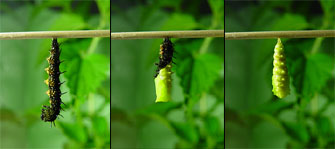on saturday, i went by a huge field of stinging nettles, and i noticed that the peacock caterpillars (inachis io, tagpfauenauge) had already left their community and spread up, so each one would have their own plant.
this is usually a sign that it won’t take long until pupation, which i thought makes a great time lapse subject.
i collected a total of 14 caterpillars, plenty of their feeding plant (=stinging nettle, urtica dioica), and went home to set up a terrarium that would fit their needs.
it took me some time to get what i needed: there should be all but one spot where they *wanted* to pupate, because time-lapse recordings require very fixed settings. eventually, i came up with a way: i let there be only one horizontal element where they could hang themselves up, and shaded that part of the terrarium.
soon, the first one settled down, and i could set up the gear.
- by the way: don’t assume that slippery glass would stop them from going anywhere – they just spread a thin carpet of silk-strands and go where *they* want.
i had no idea how long the process of pupation would take, so i set an interval of 60 seconds (speedup: 600x). 18 hours later (what a brightly enlightened night that was!), the caterpillar had already transformed into a cocoon. but my pleasure was kind-of curbed when i found out that the pupation itself only took 8 minutes, thus 8 single frames (see gallery, link on bottom).
several other caterpillars had positioned themselves in the meantime, so i picked two, “relocated” them, and began a new recording. this time, i set the interval to 4 seconds* (speedup: x 40). the resulting time-frame that i could capture, was now decreased to about an hour, so i had to stay around and unload the memorystick every now and then (so i could still capture the interesting phase).
* due to the small distance (lense – object) of only 10 cm, i decided to set the camera to aperture priority mode, which gave me a greater depth of field. of course, shutter speed was decreased and some of the pictures got blurry. also, because of sony’s “noise reduction” process, the minimum interval turned out to be 4 seconds. i think i still got a good deal…
those two caterpillars really took their time, but nearly 8.000 pictures (and one day of watching the animals; BTW: what a delight to see pupation live!) after the first caterpillar-related one, i can present a video that (i think) is worth showing:
 pupation of inachis io (download video) |
|
date: |
2005-07-10 |
|||
|
camera:
|
Sony Cybershot DSC-F717 & JG-RC2 | |||
|
video data:
|
mpeg4/xvid – one pass: quality – 10 fps – qual: 95% (get the codec | help) | |||
|
video length:
|
25 sec. | |||
|
speedup:
|
x 40 (1 second in the video equals 40 seconds in real-time) | |||
|
file size:
|
1,8 MB | |||
and here’s the result of the first session:
[view photos: time-lapse, part 6: pupating caterpillars]
can’t wait to capture them hatching out! :grin:
***edit***
they did hatch, and there’s a video available!



This is a fascinating series of picture. Using a single covered horizontal element to force the caterpillar to stay in front of the camera lens was brilliant.
Absolut wow! Klasse Idee, klasse umgesetzt.
Grüße,
Merlin
Your video is amazing! Thank you!
Bernd